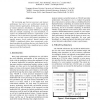Free Online Productivity Tools
i2Speak
i2Symbol
i2OCR
iTex2Img
iWeb2Print
iWeb2Shot
i2Type
iPdf2Split
iPdf2Merge
i2Bopomofo
i2Arabic
i2Style
i2Image
i2PDF
iLatex2Rtf
Sci2ools
IPPS
2002
IEEE
2002
IEEE
Memory-Intensive Benchmarks: IRAM vs. Cache-Based Machines
The increasing gap between processor and memory performance has led to new architectural models for memory-intensive applications. In this paper, we use a set of memory-intensive benchmarks to evaluate a mixed logic and DRAM processor called VIRAM as a building block for scientific computing. For each benchmark, we explore the fundamental hardware requirements of the problem as well as alternative algorithms and data structures that can help expose fine-grained parallelism or simplify memory access patterns. Results indicate that VIRAM is significantly faster than conventional cachebased machines for problems that are truly limited by the memory system and that it has a significant power advantage across all the benchmarks.
Distributed And Parallel Computing | IPPS 2002 | Memory Access Patterns | Memory Performance | Processor Called Viram |
| Added | 15 Jul 2010 |
| Updated | 15 Jul 2010 |
| Type | Conference |
| Year | 2002 |
| Where | IPPS |
| Authors | Brian R. Gaeke, Parry Husbands, Xiaoye S. Li, Leonid Oliker, Katherine A. Yelick, Rupak Biswas |
Comments (0)

